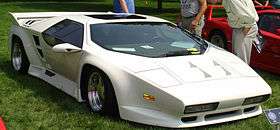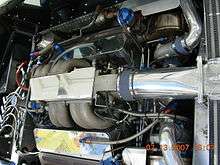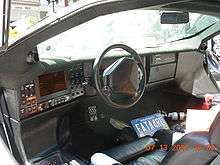Vector W8
| Vector W8 | |
|---|---|
 | |
| Overview | |
| Manufacturer | Vector Aeromotive Corporation |
| Also called | Vector W8 Twin-Turbo |
| Production |
1989–1993 22 produced[1] |
| Model years | 1990–1993 |
| Assembly | Wilmington, Los Angeles, California |
| Designer |
Gerald Wiegert David Kostka |
| Body and chassis | |
| Class | Sports car (S) |
| Body style | 2-door coupé |
| Layout | Rear transverse mid-engine, rear-wheel drive[2] |
| Platform | Carbon fiber and Kevlar body panels bonded on an aluminum honeycomb monocoque |
| Powertrain | |
| Engine | 6.0 L Rodeck twin-turbocharged V8[3] |
| Transmission | 3-speed General Motors Turbo-Hydramatic 425 automatic |
| Dimensions | |
| Wheelbase | 103.0 in (2,616 mm)[3] |
| Length | 172.0 in (4,369 mm)[3] |
| Width | 76.0 in (1,930 mm)[3] |
| Height | 42.5 in (1,080 mm)[3] |
| Curb weight | 1,506 kg (3,320 lb) (est.)[4] |
| Chronology | |
| Predecessor | Vector W2 |
| Successor | Vector WX-3 |
The Vector W8 is an American sports car produced from 1989 to 1993.[1] It was manufactured by Vector Aeromotive Corporation, and was designed by Gerald Wiegert[1][5] while receiving refinements by Vector's head of engineering David Kostka.
The company utilized the newest and most advanced aerospace materials in manufacturing the W8, and the term "Aeromotive Engineering" was used by the company when referring to the manufacturing process of the W8. Only 22 W8s were produced, including 17 customer cars, two pre-production cars, one early prototype (Vector W2), and two successor prototypes—an Avtech WX-3 and an Avtech WX-3R (roadster)—with 7.0 liter DOHC twin-turbo V8 engines. The production W8 had a base price of US$283,750 when new.[4]
History and specifications
The W8 was essentially an upgrade of the same company's earlier prototype, the Vector W2. Production was delayed after the W2 was presented to the public in 1976 due to a downturn in the world economy and insufficient financial backing. Company founder Gerald Weigert was finally able to secure sufficient financial reserves by the late 1980s, and the company grew from one building and four employees to four buildings and 80 employees, enough to accomplish Weigert's dream to create his ultimate sports car.[4] The design of the W8 was inspired by the Isdera Imperator 108i, which had a futuristic aerodynamic design. The W8 combined the design characteristics of the Imperator with technologies from fighter jets of the era. Prior to production, the W8 successfully passed DOT crash tests, as well as emissions tests. The semi-aluminum monocoque chassis was epoxy bonded and riveted with an aluminum honeycomb structure floor pan, and 5,000 aircraft specification rivets were used in the car's assembly. The body was made largely of lightweight carbon fiber and Kevlar, which are known for their strength and lightness.[3]

The car was based around a Rodeck aluminum resleevable 365 cu in (6.0 L) racing engine featuring TRW forged pistons, Carrillo stainless-steel connecting rods, stainless-steel valves, roller rocker arms, a forged crank, a dry-sump oiling system with three separate filters and braided stainless-steel hoses, with anodized red and blue fittings along with a Bosch multi-point fuel injection. The transmission was a highly modified Turbo-Hydramatic 425 General Motors three-speed automatic that had been used in front wheel drive Oldsmobile Toronados dating back some two decades earlier. The engine had intercooled Garrett twin-turbochargers, and produced an advertised 625 bhp (466 kW) at 5,700 rpm and 649 lb⋅ft (880 N⋅m) of torque at 4,900 rpm on 8 psi of boost pressure. Boost pressure levels were driver adjustable between 8 and 14 psi and during dyno testing at the factory, the engine put out 1,200 bhp (895 kW) at 14 psi of boost pressure. The W8 utilized special Michelin XGT Plus tires (255/45ZR-16s front, 315/40ZR-16s rear) bespoke to the car with wide wheels in a design made to the owner's specifications. The W8's suspension utilized double A-arms up front and De Dion tube suspension at the rear, located by four trailing arms that stretched all the way forward to the firewall. Koni adjustable shocks, with concentric springs, were used all around. Brakes were 13-inch vented discs with Alcon aluminum 4-piston calipers at the front and rear.

The interior was upholstered in premium leather and suede, along with wool carpeting and floor mats. Electrically adjustable Recaro leather seats and a premium air-conditioning system completed the luxurious interior. The seating position of the driver was slightly towards the center of the car for better drivability. The dashboard had four display screens with information about the car's status, along with buttons for adjusting the car's various functions. The dashboard displays were similar to fighter jets of the era. Some driving amenities were excluded, such as power-assisted steering and anti-lock brakes, to lower the curb weight. The W8 generated a skidpad acceleration of 0.97g, the highest in its class.[2]
Performance and aerodynamics
.jpg)
Vector claimed the W8 could reach a projected top speed of 242 mph (389 km/h), with acceleration from 0–60 mph (0–97 km/h) achievable in a time of 3.9 seconds.[5] During testing at the Bonneville Salt Flats, the W2 prototype attained a maximum speed of 242 mph (389 km/h) with a Donovan aluminum block engine that was less powerful than a production W8's engine,[6] as reported by Top Wheels magazine. This top speed was attained while still using a high downforce rear wing. Later aerodynamic testing further honed efficiency, bringing the car's drag coefficient ( ) down to just 0.32 prior to DOT crash testing in Ann Arbor, Michigan. The W8's design included subtle changes to the body during the production run, so that the initial car off the line looked slightly different from the last. Changes included the elimination of some gills, a lower front fascia and air splitter, and adjustments of the rear wing, mirror intakes, and front grill. After the top speed testing, production Vector W8s were no longer fitted with a removable glass roof due to buffeting that occurred at extreme speeds.
Road & Track magazine published tests of the W8 in its March 1991 and August 1992 issues, and praised nearly every aspect of the car's performance. In their tests, the W8 recorded a 0–60 mph acceleration time of 4.2 seconds. Despite not conducting a top speed test, they provided an estimated 218 mph (351 km/h) top speed based on the redline RPM of the W8's top gear in its 3-speed automatic transmission. The review concluded with: "Hats off to Gerald Wiegert and his team of dedicated engineers, and to all others with the fortitude and determination to have their dreams see the light of day."[4]
Successor
The AWX-3 and AWX-3R were intended to be the successors of the W8. The model designations stood for Avtech Wiegert Experimental, 3rd generation, with the R suffix meaning the roadster version. Series production of the AWX-3 never began, production of the W8 ended in 1993 after a hostile takeover by the primary shareholder, Megatech. Wiegert sued Megatech and won back the design copyrights, equipment, and remaining unsold cars. In 1995, Megatech began production of the M12 which was based on the Lamborghini Diablo and was loosely based on the design of the AWX-3.
Media

A red 1990 W8 appears in episode 15 of the 1990 American television series The Flash.
A red 1991 W8 (chassis number 003) can be seen driving across an empty lot in the early scenes of the 1993 movie Rising Sun. The car is also briefly used during a car chase at night, in which it easily outruns the police cars in pursuit, but then crashes and explodes.
A silver W8 is driven by Rutledge Wood in episode 50 of the American television series, Top Gear. The car was used to describe the beginning of American supercars and how the W8 compared to European supercars.
The Vector W8 appears in the video game Gran Turismo 2.
References
- 1 2 3 Wouter Melissen (July 25, 2005). "1990 - 1993 Vector W8 Twin Turbo". Ultimatecarpage.com. Retrieved January 7, 2009.
- 1 2 "Vector W8". Supercars.net Publishing. Retrieved January 7, 2009.
- 1 2 3 4 5 6 "1992 W8 twinturbo". Vector Motors Corporation. Archived from the original on January 18, 2009. Retrieved January 7, 2009.
- 1 2 3 4 Douglas Kott (19 May 2016). "Vector W8 Twin-Turbo First Drive". Road and Track. Retrieved 8 June 2018.
- 1 2 "Vector Motors - Company". Vector Motors Corp. Retrieved January 7, 2009.
- ↑ http://www.conceptcarz.com/z24338/Vector-W8.aspx